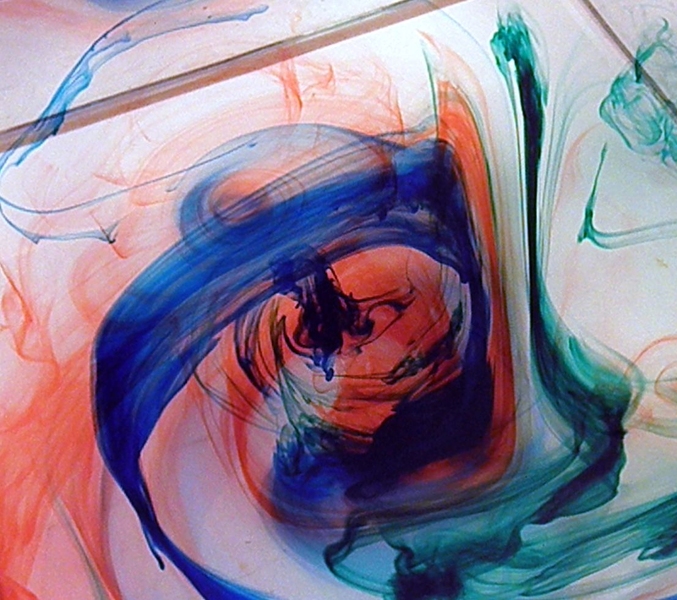Video: Melanie Gonick
Since 2001, Illari and her colleague John Marshall, the Cecil and Ida Green Professor of Oceanography, have worked to make rotating fluid dynamics more intuitive for undergraduate students studying weather and climate, using a demonstration aptly named "Weather in a Tank." The setup — a clear circular basin of water on a rotating platform that simulates Earth's spin — illustrates weather phenomena such as atmospheric cyclones, fronts, jets, and ocean currents and eddies.
In 2006, as part of a three-year study sponsored by the National Science Foundation, the team tested the setup at six universities across the United States. The researchers found that students who took part in the demonstration learned more than those who did not. The results of three years of quantitative evaluation, involving more than 700 students, have just been published in the Journal of Geoscience Education. The work was done in collaboration with Kathleen Mackin, an independent evaluator, and with Nancy Cook and Philip Sadler from the Science Education Department at the Harvard-Smithsonian Center for Astrophysics.
In many introductory college courses in weather and meteorology, rotating fluid dynamics is taught via textbook — mainly with short descriptions of weather phenomena, while more complex mathematical explanations are left for later studies. Experiments in such courses are rare, though necessary, Illari says, to connect mathematical theory with physical observations.
Putting 'Weather in a Tank' to the test
For their study, the team chose a diverse mix of colleges in which to test the demonstration, including several state universities and private institutions. The classes using the setup also varied, including introductory-level and advanced courses in ocean and atmospheric sciences, as well as classes geared toward climate majors and non-majors.
Illari and Marshall provided each school with two to three Weather in a Tank setups, as well as suggested lesson plans for 16 different experiments — eight atmospheric and eight ocean-related demonstrations. The team left it up to course instructors to choose which experiments to include in their curriculum. Students were given a test at the beginning and end of their course to test their knowledge of weather-related concepts before and after seeing the demonstrations. Questions ranged from the basic — "Why is it hotter in the summer than in the winter?" — to the more advanced, such as: "What does the frontal boundary look like between cold air from the poles and warm air from the tropics?"
Overall, Illari and Marshall found students who observed the demonstration performed better than those who did not, at both the introductory and advanced levels. The students with the greatest improvement were those in small lab groups, rather than those in larger lecture environments.
Garbage patch 101
The three-year study also spurred an unexpected outcome: Students at the University of Massachusetts at Dartmouth, working with physics professor Amit Tandon, came up with an experiment of their own, using the Weather in a Tank setup to illustrate the effects of currents in the Pacific Ocean. In particular, the students looked at a region commonly known as the Great Pacific Garbage Patch: vast quantities of marine litter held in place by currents circulating in the region.
To demonstrate the phenomenon, the students rigged up a pair of small fans opposite each other on the edge of the rotating tank to simulate the region's surface winds. They then scattered a handful of paper dots into the tank and observed them migrating along the surface, to the tank's center. Finally, the students splashed a few drops of food coloring into the tank, and observed that the dye — like the dots — collected in the center, then sank to the bottom, and rose up again at the edges of the tank. In 2008, the students detailed the demonstration in the journal Oceanography. The experiment, Illari says, is an effective demonstration of the Great Pacific Garbage Patch, and has become one of the group's flagship experiments.
Tandon says the key to getting students interested in the experiments was to ask them to predict what would happen before performing the demonstration.
"Even though the students haven't learned the theory behind it, they can question themselves and they have a stake in the matter," Tandon says. "Making the students think about what's going to happen before you actually do the experiment is really important — that's when they get a lot out of it, and change their understanding."
Since Illari and Marshall designed the weather demonstrations, more than 50 colleges in the United States and around the world have adopted the setup in climate-related courses. Illari has also taken the experiments into museums, middle schools and high schools.
"I use the experiments as a way to introduce the basics of rotating fluid dynamics," Illari says. "But it also gets students excited. You're posing questions like, 'Why do you see this?' and 'Why is this happening?' If you don't have the phenomena in front of you, it's much harder to answer."






